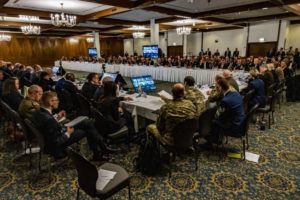Following the fourth meeting of the Contact Group on Defense of Ukraine, held on 20 July, Ukrainian Defense Minister Oleksiy Reznikov announced that his department would accelerate the transition to NATO's LOGFAS weapons control system.
How NATO uses LOGFAS
Over the years, NATO and its member states have developed information systems in a range of sectors. However, the issue of existing system compatibility and integration, as well as increasing the efficiency of building new systems, subsequently appeared, necessitating the development of a general approach.
The Logistics Committee of NATO defines important strategic logistics goals in the document NATO Logistics Vision and Objectives. This document is critical for logistics planning.
It specifies the core processes of logistical support in existing operations and drives logistics adjustments (transformations) and the creation of logistics capabilities.
Logistics Functional Area Services (LOGFAS) is a suite of tools supporting NATO's logistics processes for strategic movement and transportation, multinational deployment planning and execution, theater movement planning, and sustainment planning.
This system is developed, maintained, and supported by the Support and Business Application Service of the NATO Communications and Information Agency.
Taken out of context: CBS documentary claims on Ukrainian military aid going missing debunked
NATO has fully used the LOGFAS information system (software) since 1995. LOGFAS has successfully proven itself in supporting NATO's logistical support during operations and exercises.
The Alliance's transnational and joint compatibility is built on LOGFAS. It integrates and manages logistics information between NATO members and partners at the enterprise level.
Users can use the Service to gather, store, process, analyze, display, and distribute information to help with logistics operations. In addition, mathematical methods are used to solve some logistics problems, particularly distribution and simulation of the use of stocks (distribution).
LOGFAS interacts with NATO's and national systems such as TOPFAS operational planning information systems for medical support planning, JOCWatch event management, JChat text messaging, NIRIS tracking, IGeoSit and NCOP situational awareness systems.
Logistics planning is integral to NATO's force and defense planning processes. Logistics planning aims to identify (determine) the military and civilian capabilities required to deploy, support, and withdraw forces engaged in military operations.
The Alliance employs two types of planning processes based on its doctrinal approach. One of them is operational planning, which deals with planning concerning specific operations (missions). Another process is strategic defense planning, which deals with developing sufficient capabilities to carry out future operations.

As a result, logistics planning is integrated into both operational and defense planning. NATO's logistics capabilities are a critical component of its strategic documents.
Logistics capabilities must be developed in such a way that they increase the efficiency with which national resources are used, simplify and accelerate logistics flows, and provide command assistance for task execution. This necessitates timely, correct, and precise logistics information. The command must receive such information as soon as possible and be kept up to date on changes in the real-time regime.
ACROSS (Allied Commands Resource Optimization Software System) is an information subsystem designed to aid decision-making in the planning of stocks, particularly armament and ammunition, which are critical to the implementation of operations. ACROSS consists of the main database (LOGBASE) and several models (calculation tasks) for calculating the costs of armament and ammunition of various types of troops, namely:
The NATO Communications and Information Agency assessed the existing LOGFAS system in terms of future expansion and overall sustainability in 2010. The study's findings included the need to develop a new software tool due to moral obsolescence and the impossibility of restoring some critical parts of the software due to software developers' termination of support.
Among the requirements for the new logistics system of NATO are included functional modules from industries not considered before. Specifically, medical assistance, asset tracking, host country support, and engineering support are among the new features.
In recent years, NATO has been working on the development of a new logistics information environment, LOG FS (Logistics Functional Services), which will provide the necessary functionality for the command and control of all logistics components, including the provision of logistics information in the General Operational Picture, which is used in the planning of Alliance operations.
LOG FS is expected to make the best use of existing resources and capabilities, particularly LOGFAS components, while also adding new functions to meet existing needs. At the same time, NATO is clarifying requirements in the defense planning process.
The new logistics information system LOG FS is still in the testing phase. However, according to the latest estimates, due to delays in the implementation of LOG FS, it is expected that the use of LOGFAS will be extended until 2025. This includes the modification of LOGFAS components during this period.
Through automation, the militaries of 30 Allies can instantly share national data with LOGFAS, allowing NATO to track multinational movements at NATO's Movement Coordination Center in Ulm, Germany.
Despite requests for a software complex more integrated into military planning, currently, LOGFAS allows to work successfully with separate data sets from both the Alliance itself and individual NATO member countries and partner countries (Bosnia and Herzegovina, Georgia, European Defense Agency, etc.)
More control is needed
As for the control system over the supply of military aid to Ukraine, Ukraine's partner countries used the export control system for weapons before the start of the full-scale Russian invasion.
This system needed to be revised with the increase in nomenclature and volume after February 2022.
According to Ukraine's key partners, this process is currently as transparent as the current military situation allows. After all, we should not forget that the military aid supplied to Ukraine is a potential target for hostile actions by the Russian Federation.
The EU has implemented its own monitoring and control mechanism to ensure that Ukraine uses equipment provided by EU member states for these stated purposes. The procedure for controlling the movement of equipment delivered using the European Peace Fund is ensured both during and after the delivery process.
As the EU foreign and security policy spokesman notes, military aid is subject to strict control and safeguards, even when it has already been delivered to Ukraine.
This mechanism includes monitoring the use of such equipment, taking into account international norms regarding human rights and humanitarian law compliance, and the possibility of regular on-site information (checking) of the current state of this equipment, when necessary and possible for security reasons.
Ukraine agreed not to transfer or re-export the delivered defense equipment and weapons for any purpose other than use by the Armed Forces officially recognized by the European Union.
In turn, NATO is convinced that Ukraine properly safeguards and accounts for the weapons received from allies in order to exercise its right to self-defense against Russian aggression.
The Alliance has not disclosed the procedure or technical tools used to carry out this control.
Military aid to Ukraine is coordinated by the military, diplomatic departments, state power structures of Ukraine, and state bodies of the countries providing weapons and military equipment. In order to ensure these supplies, logistics centers were created in Europe, which has a system of accounting for military equipment and tracking it in real-time regime.
In particular, an operational group from the US Armed Forces' European Command is based in Stuttgart and is tasked with coordinating Ukraine's requests for military aid, as well as finding and delivering them to the country's border.
Normal end-use monitoring procedures for Western weapons in Ukraine are unsuitable for areas of active hostilities. Currently, the United States, the United Kingdom, and other allies must rely on information provided by Ukrainians regarding the use of the provided weapons.
Private companies mostly produce military equipment in NATO countries, but arms export control legislation strictly regulates its sale to third countries.
In particular, the US government is required to constantly monitor the use of American-made weapons by any state that receives them (end-use monitoring).
“We are again facing centuries-old enemy together” : Ukraine’s Army chief greets Poles on Army Day
US calls for more red tape
It calls for regular physical inspections of American-made weapons in foreign countries, as well as requests for their location and a review of reports on their use. In this way, the United States ensures that American weapons do not fall into the hands of enemies, hostile countries, or criminals.
The Pentagon's announcement that it is considering deploying civilian weapons inspectors to Ukraine was a defining moment. This was stated by Jed Royal, deputy director of the US Pentagon Agency for Defense Cooperation, in early July.
Even during the adoption of the Lend-Lease Act for Ukraine, American congressmen declared the need for more control regarding the use of military aid to Ukraine. In May, Republicans John Kennedy and Rand Paul proposed creating the position of an inspector who would check Ukraine's use of military aid.
In June, Democratic Senator Elizabeth Warren called on the US government to be more accountable for billions of dollars in military aid to the Ukraine.
Such discussions indicate that the issue of consolidation of reporting on the distribution, use, and disposal of weapons received from Western allies has been put on the agenda for Ukraine.
The significance of this issue will expand proportionally to the increase in military help from Ukrainian allies. Over time, the lack of automated reporting on the provision of weapons, equipment, and ammunition that is comprehensible to allies may become an impediment to the West's ability to provide additional defense assistance.
In recent weeks, Ukraine has made numerous significant steps pertaining to the control of the weapons provided to the country.
Tasks for Ukraine: What will change in the coming future?
Thus, the Ukrainian Defense Procurement Agency will begin operating in accordance with the regulations of the NATO Support and Procurement Agency. This will, according to the objective of the Ministry of Defense, make the acquisition of weapons for the Armed Forces as open as feasible and eliminate potential corruption concerns.
In addition, the Defense Procurement Agency was intended to be established between January and March of this year. However, these terms were postponed owing to the Russian Federation's aggression. Finally, a few weeks ago, the agency was officially registered and began operations.

Currently, it is understood that the Defense Procurement Agency's activities will be supervised and reviewed by the Advisory Council on Defense Reform, a high-level international advisory council including not just Ukrainian officials but also specialists from NATO member states.
The status under which this advisory group will operate will become clear after the publication of the key founding documents for the newly created agency.
According to material issued by the Ministry of Defense, Ukraine will employ specialized information systems to monitor, control, and provide logistical support for military equipment and weaponry supplied by partner countries.
The Minister of Defense of Ukraine stated this during the presentation of a new module of the SOTA information and analytical system, which was specially created to monitor the supply of weapons to Ukraine.
According to the announcement, the SOTA system will allow monitoring of the supply of weapons by status (ready for shipment, in route, or received to the unit of the Armed Forces of Ukraine), and the countries that transferred them will analyze the supply of weapons in time, by period (when it was adopted/decommissioned), classify according to NATO standards, referring to Soviet models, etc.
This module allows you to calculate the supply of ammunition to military units, monitor how supply plans are being carried out, and control the distribution between units.
The weapons monitoring module is integrated with the general portal for various data blocks, including the situation on the front lines, the deployment of forces, missile strikes on the territory of Ukraine, shelling of populated areas, and the geographical linking of messages related to military actions, emergencies, and media messages.
The Minister of Defense of Ukraine claimed that the transfer of weapons to Ukraine is also managed via the LOGFAS information system, to which Ukraine was granted access in 2019. According to the minister, domestic military universities teach this technology, and he just requested that NATO give additional licenses and terminals.
Beginning in September 2019, the Institute of Operational Support and Logistics of the Ivan Chernyakhovych National Defense University of Ukraine will conduct a training session for LOGFAS system users. In addition, representatives from the Multinational Logistics Coordination Center of the NATO Liaison Office of the NATO Representation in Ukraine trained Ukrainian logistics officers.
During the course, the main focus of the participants was on studying the procedures for planning the logistical support of the troops using the principles of reporting the logistical support of the LOGREP module, which is a key element of LOGFAS.
The ADAMS component plans, estimates, and models (simulates) movement and transportation to support operations. This subsystem has successfully reduced deployment planning time and provided a means of sharing unit deployment data between Alliance nations. The CORSOM component is designed to plan, monitor, and eliminate conflicts during reception actions, organization, and movement of forces during their deployment according to detailed plans from ADAMS. Among other things, CORSOM supports detailed planning and coordination of ground movement and military transportation from offloading sites to unit destinations, traffic monitoring, convoy and train administration, situational awareness, alternative route selection, etc.
LOGREP is used to generate standardized reports as well as map and network analysis, create and manage force profiles, available stocks, and supply item lists.
The LOGREP subsystem is designed to replace the formation of traditional (paper) logistics reporting with the exchange of packages (databases) of structured data in electronic form.
According to specialists, the LOGFAS system can supply a portion of the required logistical support planning activities in Ukraine for defense and operational planning logistics. However, it could take approximately two years to completely implement the program.
Given that English and French are the official languages of the NATO, the interface of the LOGFAS system was built primarily in these two languages. Given the leadership of the Ukrainian Ministry of Defense's desire to adopt the LOGFAS reporting system up to the battalion level, there may be concerns with the requisite level of English for officers in command. However, this is not the primary cause.
In order to use LOGFAS for the needs of Ukraine, it will also be necessary to prepare the format of input data of the system and download a significant amount of data from all offices and agencies of Ukraine's security and defense sector.
However, according to the information available to the specialists, the LOGFAS system does not provide, in particular, the functions of accounting for the availability and movement of material resources, processing applications for movement, and other documents, which are the important component of operational logistics in Ukraine.
LOGFAS allows you to work with separate data sets, including data from individual countries. In order to utilize LOGFAS in Ukraine, it is important to establish the system input data format and download a substantial quantity of data.
In addition, a number of methods utilized in creating the information system are not released and are not disclosed to other nations (non-NATO members) due to their restricted information access.
Chinese state media spread Russian propaganda about Ukraine war
Ukraine's decision to simultaneously implement the SOTA information-analytical system and its gradual integration into the LOGFAS modules may be related to this circumstance.
Main advantages of using LOGFAS in Ukraine - the possibility of quick commissioning and obtaining practical results (since the software is already in use and does not require time for development) and full compliance with NATO standards.
Disadvantages - the system is morally outdated and does not meet the strategic needs of NATO countries today.
Therefore, the Ukrainian state, during the period of war should use the best practices and implement software that to keeps up with the requirements of the time. Furthermore, with the assistance of the NATO member countries, Ukraine should carefully study the possibility of the pilot implementation of LOG FS (or its analog) in Ukraine.
The general conclusion is as follows: Despite the propaganda campaign generated by Moscow on the illegal trafficking of weapons delivered to Ukraine, Ukraine's partners today have a great deal of confidence in the Ukrainian government's efforts.
However, to improve the management level of its own armed forces and the logistics of supplies from allies, Ukraine must implement advanced solutions. Undoubtedly, one should include the installation of a logistics support information system compatible with NATO requirements for the Armed Forces.
The logic of this process in the field of arms supplies for Ukraine is simply put, if you want to be closer to your partners, implement clear procedures and speak the same "technical" language.
Read More:
- Taken out of context: CBS documentary claims on Ukrainian military aid going missing debunked
- What’s wrong with Amnesty International’s conclusions that “Ukrainian fighting tactics endanger civilians”
- What Ukraine really needs to launch a counteroffensive against Russi
- “We are again facing centuries-old enemy together” : Ukraine’s Army chief greets Poles on Army Day
- Some 450 foreign-made microelectronic components identified in Russian weapons recovered in Ukraine – RUS
- 300 MLRS is a “good number” for Ukraine: Ukrainian military expert on achieving weapons parity with Russia
- Many countries ask to keep the weapons they give Ukraine a secret – Ukraine’s RNBO chief Danilov
- Chinese state media spread Russian propaganda about Ukraine war






